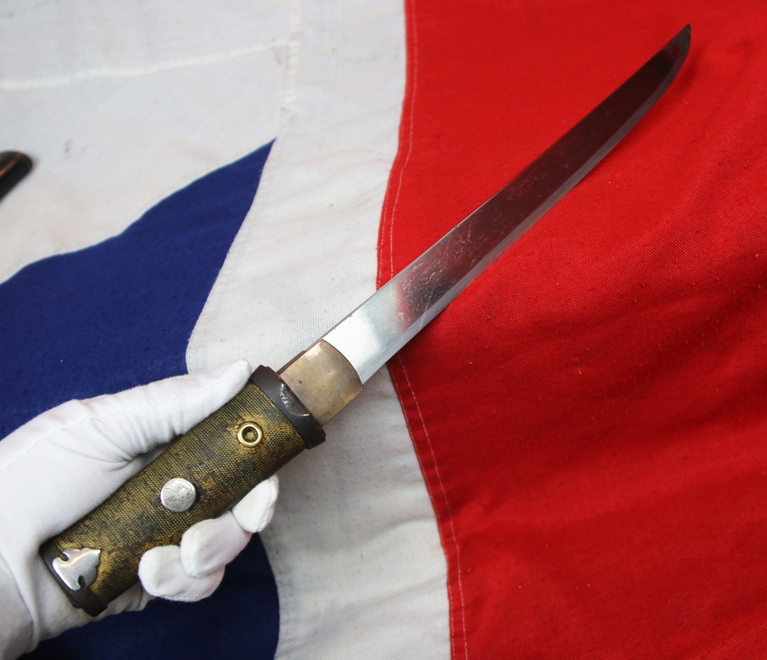A Beautiful, Ancient Japanese 15th Century Samurai's Dagger Aikuchi Tanto
An absolute joy to see such a beautiful and fine aikuchi tanto from ancient Japan, from the Koto period of the Muromachi era Circa 1400's. Fine Edo period matching koshirae, of the fuchigashira, koiguchi & kojiri hilt mounts and top and bottom scabbard mounts are entomological based, with catydids over an iron ground, the catydids are decorated with pure gold. The saya has a superb shakudo deep takebori mount of mount fuji topped with pure gold lava with crashing waves below, also with decorated pure gold sea spray droplets. The menuki are silver mon engraved with Aoi mon of the Tokugawa Shoguns. Kozuka side knife is an iron plate inlaid with a gold kanji seal, and ancient form kanji script and also a gilded cicada to match the theme of the fittings and mounts. The tsuka binding is micro tsuka-ito decorated with gold leaf, and two silver side mounts off the kashira. The blade has its old polish finish showing super grain in the hada and a very well defined hamon. Insects have been celebrated in Japanese culture for centuries. The Lady Who Loved Insects is a classic story of a caterpillar-collecting lady of the 12th century court; the Tamamushi, or Jewel Beetle Shrine, is a seventh century miniature temple, once shingled with 9,000 iridescent beetle forewings. In old Japanese literature, poems upon insects are to be found by thousands, Daisaburo Okumoto is director of the Fabre Insect Museum. An avid insect collector and a scholar of French literature, he has translated many of Fabre's works. He ascribes the popularity of insects in Japan to national character. It seems like Japanese eyes are like macro lenses and Western eyes are wide-angle, he says. A garden in Versailles, it's very wide and symmetrical. But Japanese gardens are continuous from the room and also very small. We feel calm when we look at small things. The medieval Japanese monk Yoshida Kenko put it this way: ?If man were never to fade away like the dews of Adashino, never to vanish like the smoke over Toribeyama, how things would lose their power to move us! The Muromachi era Onin War (1467-77) led to serious political fragmentation and obliteration of domains: a great struggle for land and power ensued among bushi chieftains and lasted until the mid-sixteenth century. Peasants rose against their landlords and samurai against their overlords as central control virtually disappeared. The imperial house was left impoverished, and the bakufu was controlled by contending chieftains in Kyoto. The provincial domains that emerged after the Onin War were smaller and easier to control. Many new small daimyo arose from among the samurai who had overthrown their great overlords. Border defences were improved, and well fortified castle towns were built to protect the newly opened domains, for which land surveys were made, roads built, and mines opened. New house laws provided practical means of administration, stressing duties and rules of behaviour. Emphasis was put on success in war, estate management, and finance. Threatening alliances were guarded against through strict marriage rules. Aristocratic society was overwhelmingly military in character. The rest of society was controlled in a system of vassalage. The shoen (feudal manors) were obliterated, and court nobles and absentee landlords were dispossessed. The new daimyo directly controlled the land, keeping the peasantry in permanent serfdom in exchange for protection. The most precious thing in life is its uncertainty. 12 inch blade overall 19 inches long. As with all our items it comes complete with our certificate of authenticity.
Code: 23026










